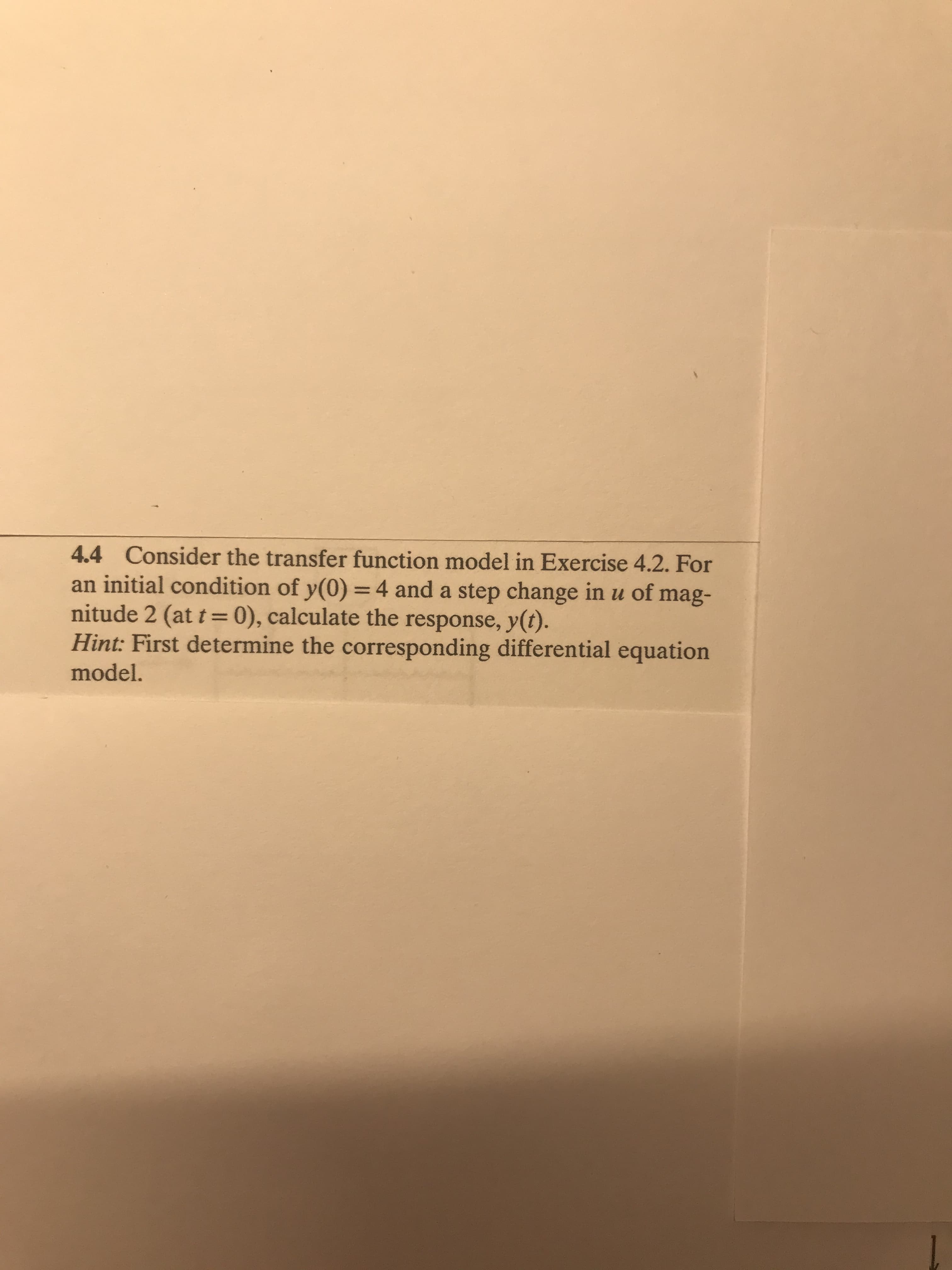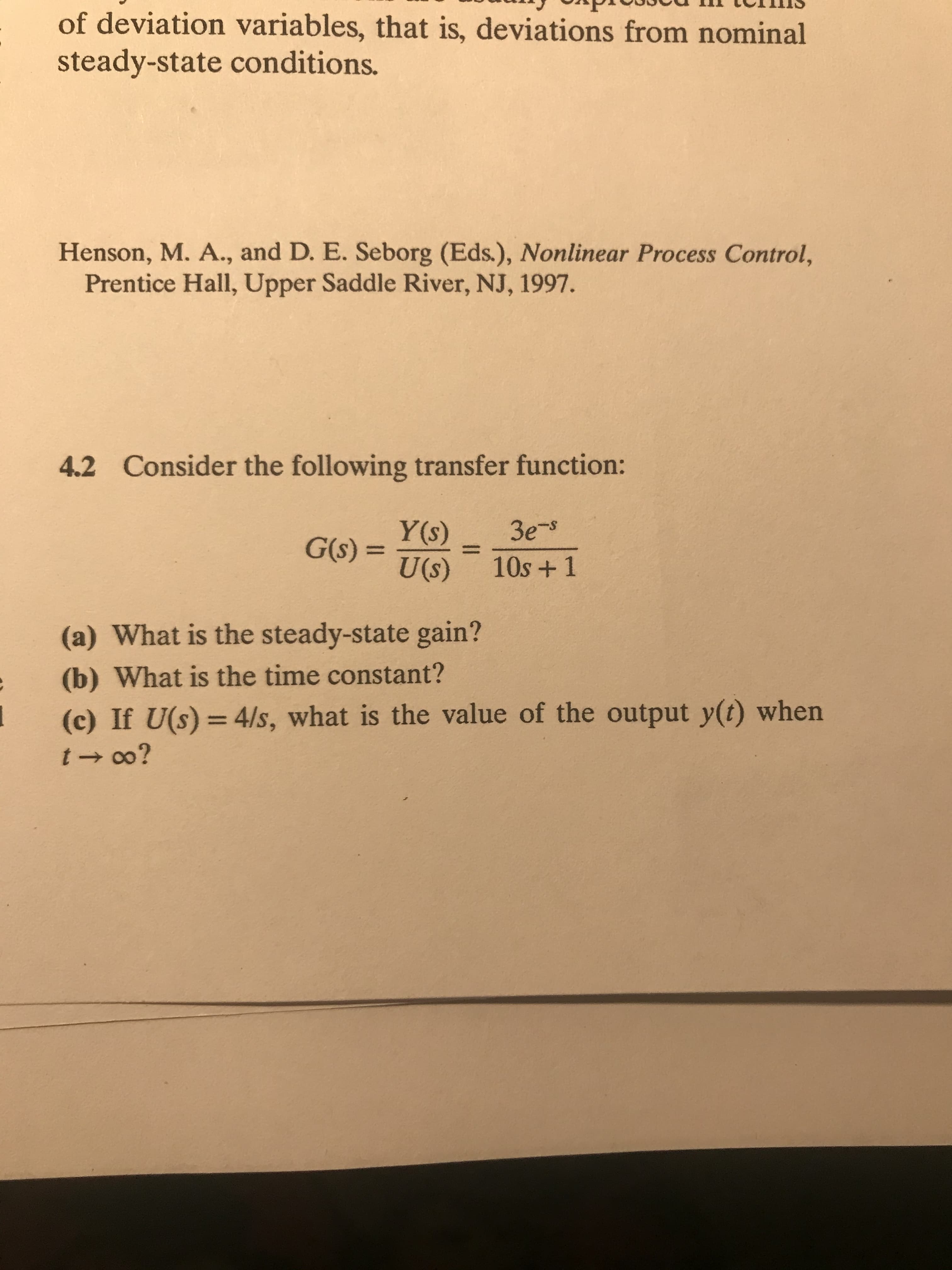4.4 Consider the transfer function model in Exercise 4.2. For an initial condition of y(0) =4 and a step change in u of mag- nitude 2 (at t =0), calculate the response, y(t). Hint: First determine the corresponding differential equation model. of deviation variables, that is, deviations from nominal steady-state conditions. Henson, M. A., and D. E. Seborg (Eds.), Nonlinear Process Control, Prentice Hall, Upper Saddle River, NJ, 1997. 4.2 Consider the following transfer function: Зе Y(s) G(s) = U(s) %3D 10s +1 (a) What is the steady-state gain? (b) What is the time constant? (c) If U(s) = 4/s, what is the value of the output y(t) when %3D t - 0o?
4.4 Consider the transfer function model in Exercise 4.2. For an initial condition of y(0) =4 and a step change in u of mag- nitude 2 (at t =0), calculate the response, y(t). Hint: First determine the corresponding differential equation model. of deviation variables, that is, deviations from nominal steady-state conditions. Henson, M. A., and D. E. Seborg (Eds.), Nonlinear Process Control, Prentice Hall, Upper Saddle River, NJ, 1997. 4.2 Consider the following transfer function: Зе Y(s) G(s) = U(s) %3D 10s +1 (a) What is the steady-state gain? (b) What is the time constant? (c) If U(s) = 4/s, what is the value of the output y(t) when %3D t - 0o?
Introduction to Chemical Engineering Thermodynamics
8th Edition
ISBN:9781259696527
Author:J.M. Smith Termodinamica en ingenieria quimica, Hendrick C Van Ness, Michael Abbott, Mark Swihart
Publisher:J.M. Smith Termodinamica en ingenieria quimica, Hendrick C Van Ness, Michael Abbott, Mark Swihart
Chapter1: Introduction
Section: Chapter Questions
Problem 1.1P
Related questions
Question
100%

Transcribed Image Text:4.4 Consider the transfer function model in Exercise 4.2. For
an initial condition of y(0) =4 and a step change in u of mag-
nitude 2 (at t =0), calculate the response, y(t).
Hint: First determine the corresponding differential equation
model.

Transcribed Image Text:of deviation variables, that is, deviations from nominal
steady-state conditions.
Henson, M. A., and D. E. Seborg (Eds.), Nonlinear Process Control,
Prentice Hall, Upper Saddle River, NJ, 1997.
4.2 Consider the following transfer function:
Зе
Y(s)
G(s) =
U(s)
%3D
10s +1
(a) What is the steady-state gain?
(b) What is the time constant?
(c) If U(s) = 4/s, what is the value of the output y(t) when
%3D
t - 0o?
Expert Solution
This question has been solved!
Explore an expertly crafted, step-by-step solution for a thorough understanding of key concepts.
This is a popular solution!
Trending now
This is a popular solution!
Step by step
Solved in 8 steps with 8 images

Recommended textbooks for you

Introduction to Chemical Engineering Thermodynami…
Chemical Engineering
ISBN:
9781259696527
Author:
J.M. Smith Termodinamica en ingenieria quimica, Hendrick C Van Ness, Michael Abbott, Mark Swihart
Publisher:
McGraw-Hill Education

Elementary Principles of Chemical Processes, Bind…
Chemical Engineering
ISBN:
9781118431221
Author:
Richard M. Felder, Ronald W. Rousseau, Lisa G. Bullard
Publisher:
WILEY

Elements of Chemical Reaction Engineering (5th Ed…
Chemical Engineering
ISBN:
9780133887518
Author:
H. Scott Fogler
Publisher:
Prentice Hall

Introduction to Chemical Engineering Thermodynami…
Chemical Engineering
ISBN:
9781259696527
Author:
J.M. Smith Termodinamica en ingenieria quimica, Hendrick C Van Ness, Michael Abbott, Mark Swihart
Publisher:
McGraw-Hill Education

Elementary Principles of Chemical Processes, Bind…
Chemical Engineering
ISBN:
9781118431221
Author:
Richard M. Felder, Ronald W. Rousseau, Lisa G. Bullard
Publisher:
WILEY

Elements of Chemical Reaction Engineering (5th Ed…
Chemical Engineering
ISBN:
9780133887518
Author:
H. Scott Fogler
Publisher:
Prentice Hall


Industrial Plastics: Theory and Applications
Chemical Engineering
ISBN:
9781285061238
Author:
Lokensgard, Erik
Publisher:
Delmar Cengage Learning

Unit Operations of Chemical Engineering
Chemical Engineering
ISBN:
9780072848236
Author:
Warren McCabe, Julian C. Smith, Peter Harriott
Publisher:
McGraw-Hill Companies, The